Key takeaways:
- Women’s health advocacy amplifies women’s voices and addresses their unique healthcare needs, emphasizing the importance of community collaboration and personal narratives for driving change.
- Engaging with policymakers and building relationships are crucial, as personal stories can influence their understanding and lead to effective health policies.
- Utilizing data alongside personal experiences strengthens advocacy efforts, making a compelling case for addressing women’s health disparities and improving healthcare access.
- Sharing personal stories allows for emotional connections, turning abstract discussions into urgent calls for action and highlighting the real impact of systemic issues on individuals.
Understanding women’s health advocacy
Women’s health advocacy is about amplifying the voices of women and ensuring their unique healthcare needs are met. I remember attending a local town hall where a group of women shared their stories about inadequate care for reproductive health issues. It struck me how personal experiences can fuel a powerful movement; these stories serve not just to inform but to motivate change.
When I think about women’s health advocacy, I often reflect on the systemic barriers that women face. Have you ever considered how gender biases can shape medical research and treatment options? This reality underscores the importance of advocating for more inclusive policies that genuinely consider the diverse experiences of women. It’s not just about health; it’s about dignity and respect in healthcare settings.
Moreover, building a community around women’s health advocacy is crucial. I recall a workshop where we brainstormed strategies to unite various stakeholders — from individual advocates to healthcare providers. The energy in the room was palpable; it reminded me that when we collaborate, we can drive meaningful change. How can we harness such collective power to ensure that every woman has access to the care she deserves?
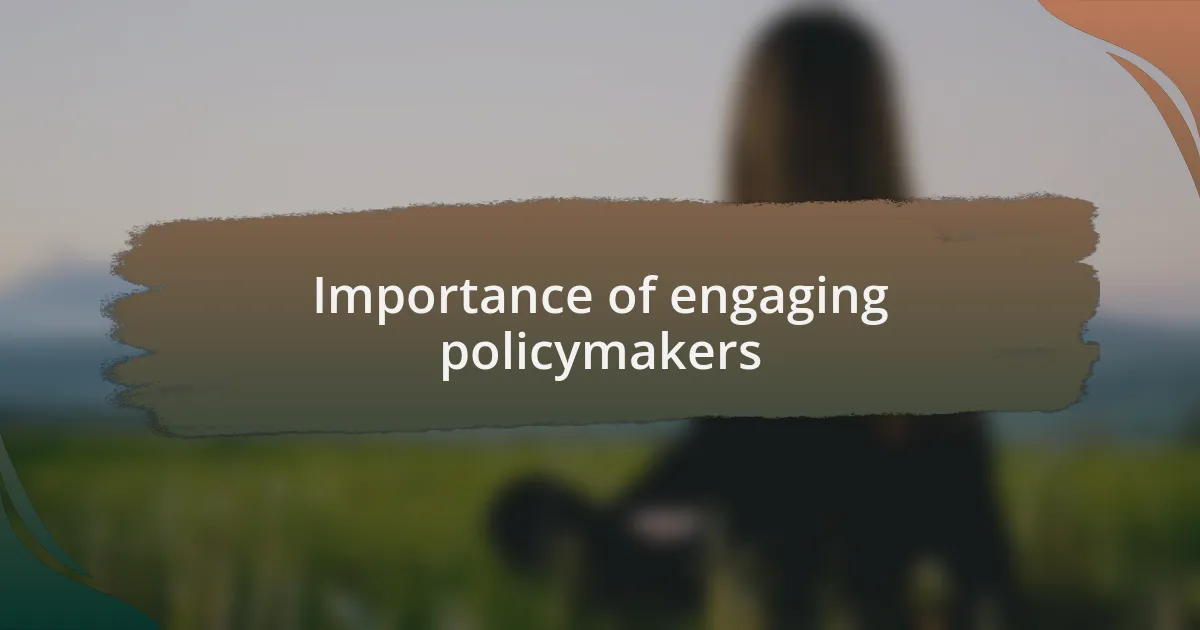
Importance of engaging policymakers
Engaging policymakers is vital because they hold the keys to creating and implementing effective health policies. I remember participating in a meeting where a local legislator listened intently to our concerns about maternal health disparities. It struck me how, in that moment, a single conversation could have the potential to shape policies that directly impact women’s lives. How often do we overlook the influence of those in power who can effect change when prompted by our advocacy?
Effective advocacy involves transforming personal experiences into policy action. When I shared my story about healthcare access challenges with a policymaker, I saw their eyes open to the real implications of bureaucracy. Isn’t it fascinating that our individual narratives can be powerful tools to persuade decision-makers? By shedding light on these issues, we help them recognize the urgency of addressing women’s health needs.
Furthermore, building relationships with policymakers cultivates trust and understanding. Once, I followed up on a discussion with a city representative, offering additional research that highlighted women’s health statistics in our community. This proactive approach not only strengthened our connection but also showed that I was invested in the cause. What if we all took that extra step to keep the conversation going? Engaging with policymakers is not just about presenting issues; it’s about fostering ongoing dialogue that can lead to sustained change in women’s health advocacy.
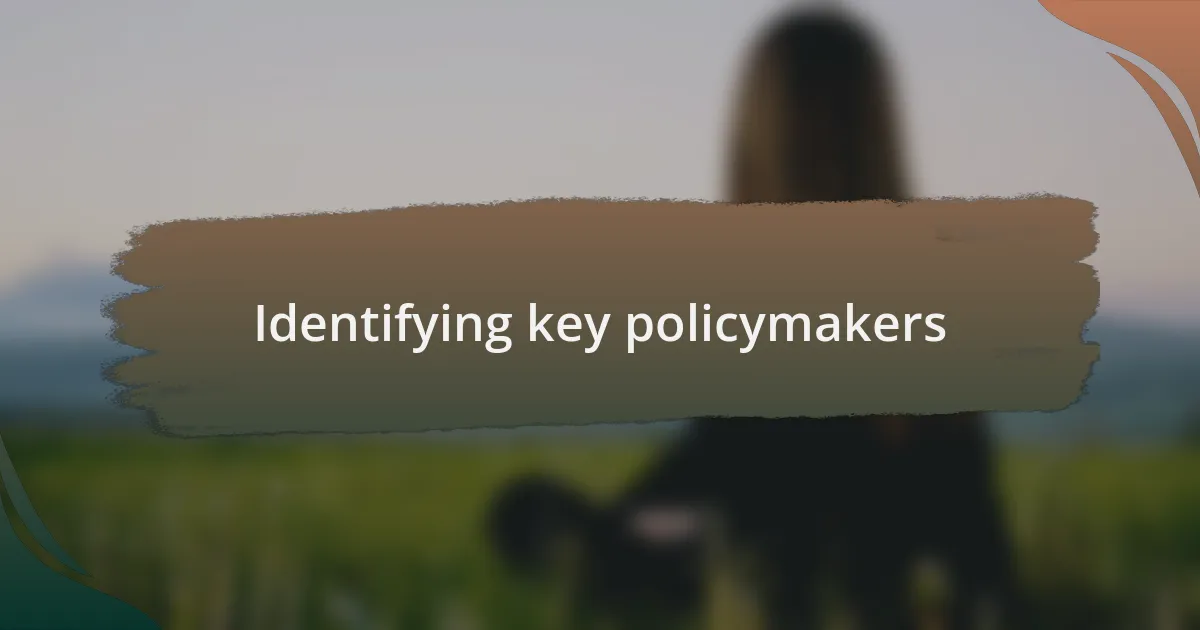
Identifying key policymakers
Identifying key policymakers starts with understanding the structures that influence women’s health decisions at local, state, and national levels. I recall attending a community forum where I learned about various committees focused on health issues. It was eye-opening to see how many individuals shape our health policies, often beyond the more visible elected officials. Who knew that behind every bill, there are numerous stakeholders whose voices can sway outcomes?
I’ve found that focusing on specific candidates or elected officials who have a history of supporting women’s health initiatives is crucial. During a local election, I researched candidates’ platforms and discovered a city council member who had championed maternal health funding. This insight fueled my enthusiasm as I reached out to express my support and share personal stories that aligned with their vision. Isn’t it empowering to realize that your voice can resonate with those who are already in the advocacy game?
Moreover, attending town hall meetings or webinars can be instrumental in identifying these key players. I once engaged with a policymaker casually after a seminar and was surprised to learn about their interest in addressing health equity. It reminded me that connections often emerge naturally in these settings, and sometimes, all it takes is one conversation to pinpoint the right advocate. How often do we seize these opportunities to influence the decision-makers who can advocate for women’s health?
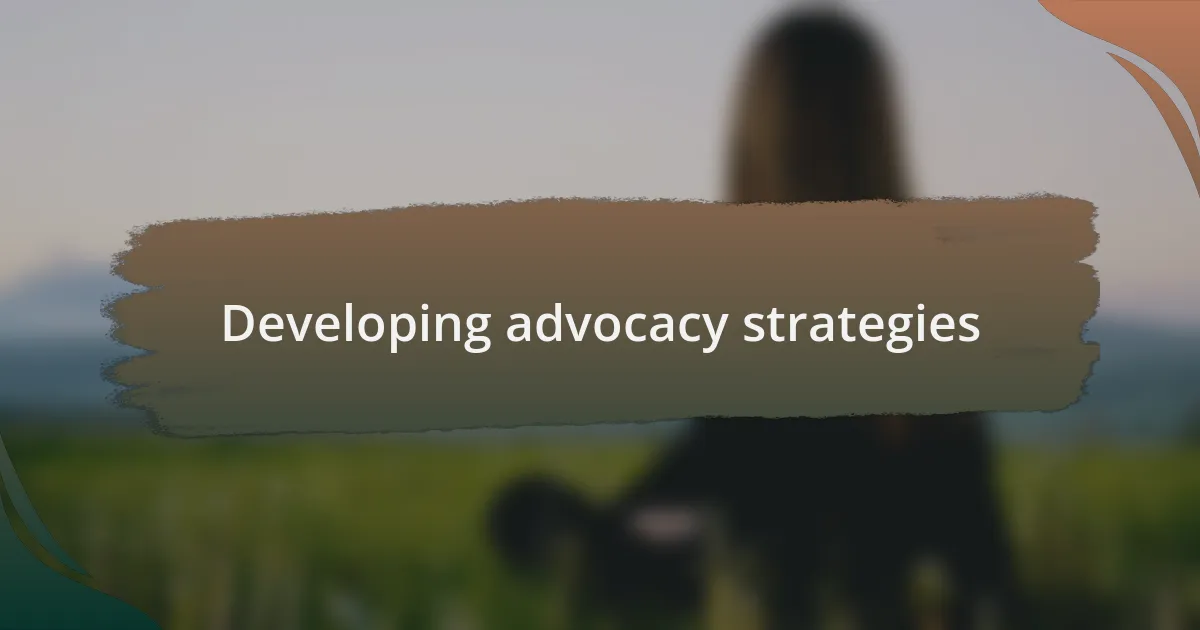
Developing advocacy strategies
Developing effective advocacy strategies requires a deep understanding of the unique concerns at the heart of women’s health. I remember once working on a campaign that aimed to increase awareness about mental health resources for postpartum women. We started by gathering testimonials from mothers that highlighted their struggles, which not only conveyed the importance of the issue but also created a powerful emotional narrative that captured the attention of our audience. Isn’t it remarkable how personal stories can serve as a catalyst for change?
Another essential element in crafting advocacy strategies is building coalitions. Collaborating with organizations that share similar goals can amplify your message significantly. I partnered with a local women’s group for a health fair, blending our resources to host workshops and reach a larger audience. This synergy not only widened our impact but also fostered a sense of community, showing that we were collectively invested in this cause. Have you ever thought about the exponential power of teamwork in advocacy?
Finally, I’ve learned that being flexible and responsive to the political landscape is vital. For instance, during a sudden public health crisis, we shifted our focus to address urgent needs rather than our pre-planned initiatives. This adaptability won us support from policymakers who appreciated our immediate relevance. Isn’t it fascinating to see how quick adjustments to your strategy can resonate at the heart of pivotal moments?
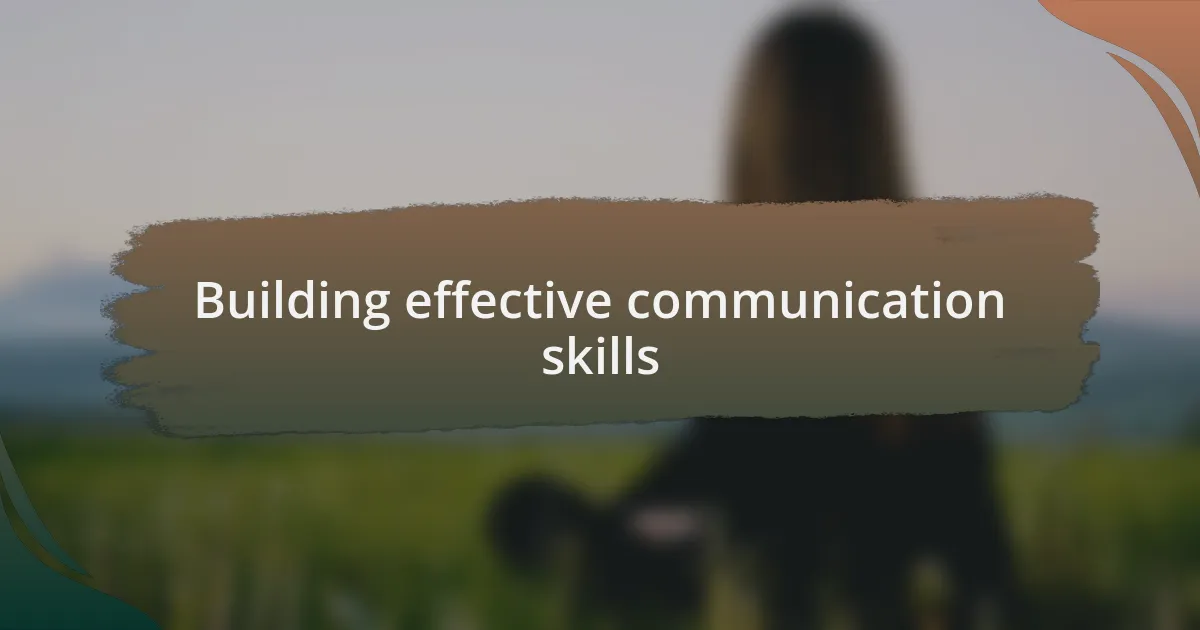
Building effective communication skills
Building effective communication skills is essential for any advocacy effort. I recall my early days in outreach when I struggled to convey complex health information clearly. After attending a workshop on storytelling, I learned to break down intricate topics into relatable narratives. Suddenly, I felt empowered to articulate my thoughts. Have you ever found yourself lost in jargon, wishing you could simplify your message for your audience? Recognizing this need is the first step toward improvement.
Additionally, active listening has transformed my interactions with policymakers. During a meeting, I made a conscious effort to focus on their concerns while noting how our goals aligned. This approach not only fostered rapport but also led to a deeper understanding of their priorities. It’s surprising how often we overlook the importance of listening; wouldn’t you agree that truly hearing others can pave the way for more meaningful dialogue?
Finally, practicing empathy has proven invaluable in my advocacy journey. I remember a crucial presentation where I shared not just data but also personal stories of women affected by health disparities. I could feel the emotional connections forming in the room. The audience wasn’t just hearing statistics; they were feeling the weight of the stories behind them. How often do we recognize that facts alone rarely move hearts? Blending emotion with information can create a powerful impact that resonates deeply.
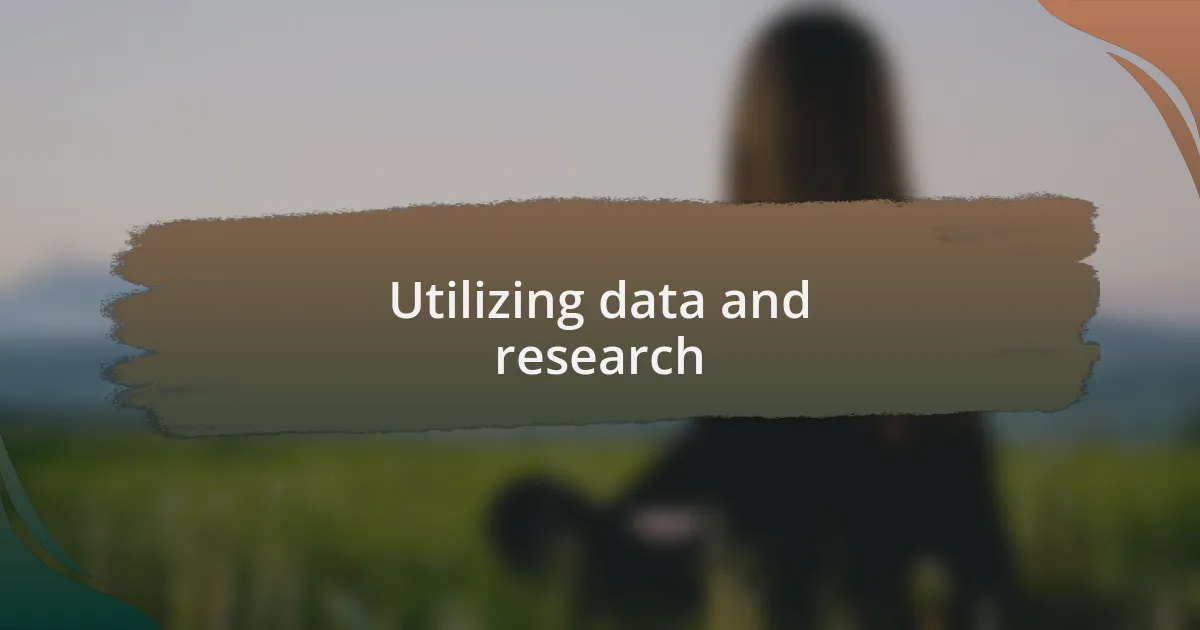
Utilizing data and research
Utilizing data and research is a game-changer in my advocacy arsenal. When I first compiled a report on maternal health trends in our community, I was initially overwhelmed by the numbers. It wasn’t until I highlighted specific disparities, like the vastly different access to prenatal care among various demographics, that I truly saw policymakers sit up and take notice. Isn’t it fascinating how the right data can shift perspectives?
One memorable experience was presenting findings on the correlation between mental health services and overall women’s health outcomes. I backed my claims with extensive research, highlighting how investments in mental health support could reduce hospitalization rates among women. I still remember the look on a policymaker’s face when the data clearly indicated potential cost savings. How often do we underestimate the power of well-placed statistics to sway opinions?
Research doesn’t have to be dry—it’s about storytelling with numbers. During a campaign for improved reproductive health education, I shared compelling data alongside powerful testimonials from women who faced real struggles. This combination of hard facts and relatable human experiences drew a stronger response. Have you considered how pairing your data with personal stories could elevate your advocacy message? By blending research with real-world impacts, we can make a memorable case that resonates on multiple levels.
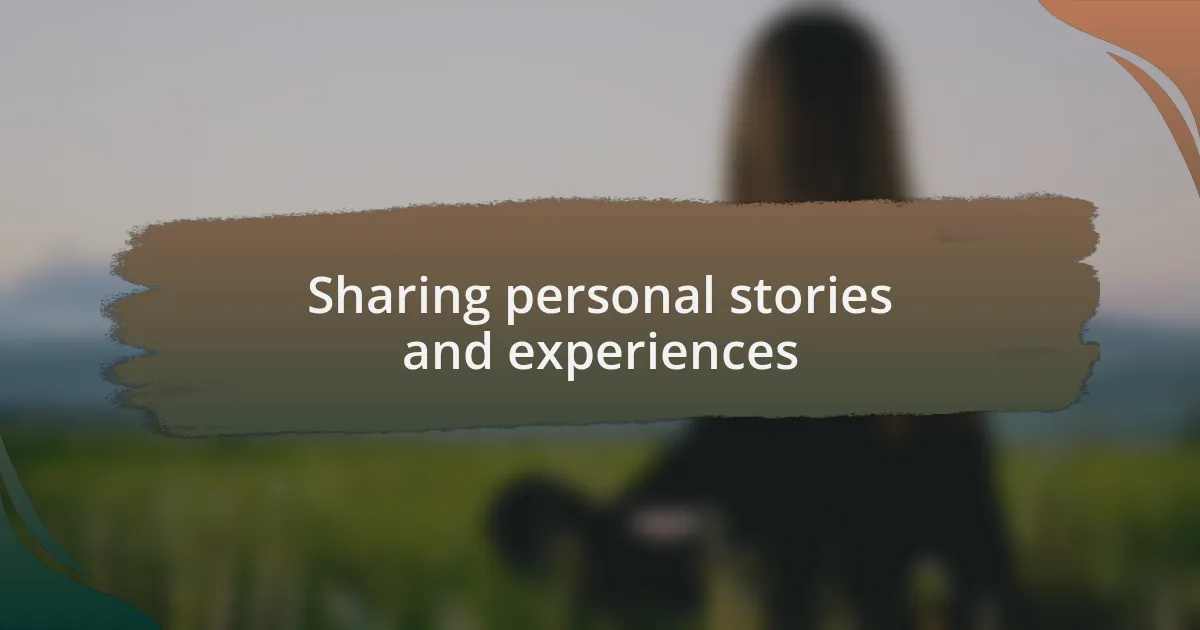
Sharing personal stories and experiences
Sharing personal stories and experiences can be one of the most powerful tools in advocacy. I recall a time when a woman in our support group shared her journey through a challenging pregnancy. Her narrative was raw and emotional, detailing the struggles she faced within the healthcare system. By simply sharing her story, she not only connected with many in the room but also caught the attention of policymakers who were present, making them reconsider the policies that directly impact women’s healthcare access.
In another instance, after attending a community event, I met a young mother who had been denied reproductive health services due to overly strict regulations. Listening to her, I felt a rush of empathy. How can we turn a blind eye to such personal experiences that highlight systemic failures? I decided to channel her story into my next meeting with local representatives, emphasizing that behind every statistic lies a real person facing immense challenges. By making her situation front and center, we painted a vivid picture that numbers alone couldn’t convey.
It’s remarkable how sharing a genuine experience can shift conversations. At a hearing about maternal health resources, I shared my own struggle with postpartum depression and the lack of accessible support. The room was silent, yet charged with emotion. Have you ever noticed how personal stories can turn a sterile discussion into a compelling call to action? By inviting policymakers into our realities, we not only humanize the issues but also awaken a sense of urgency to make meaningful change.